
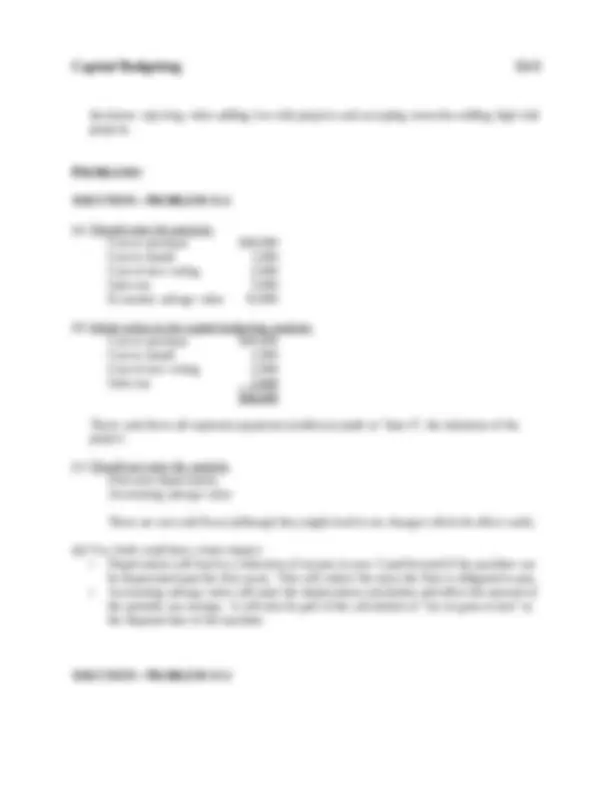
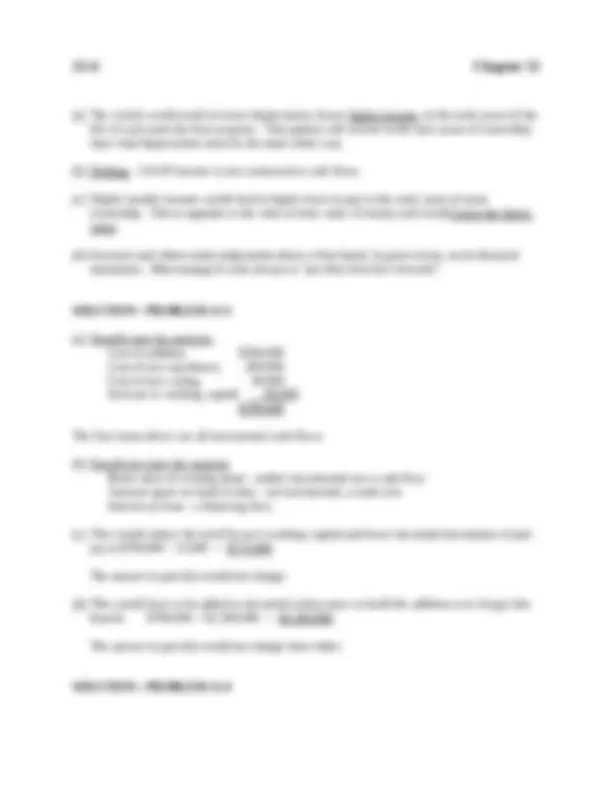
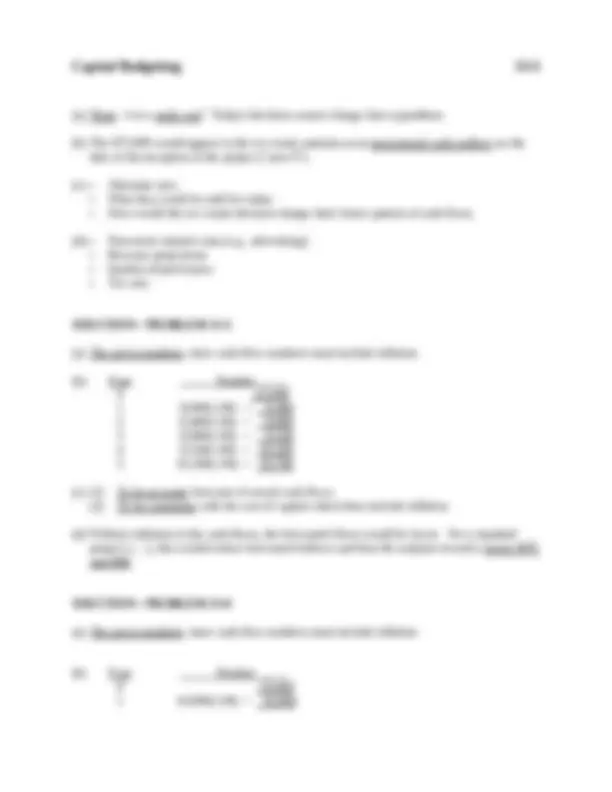
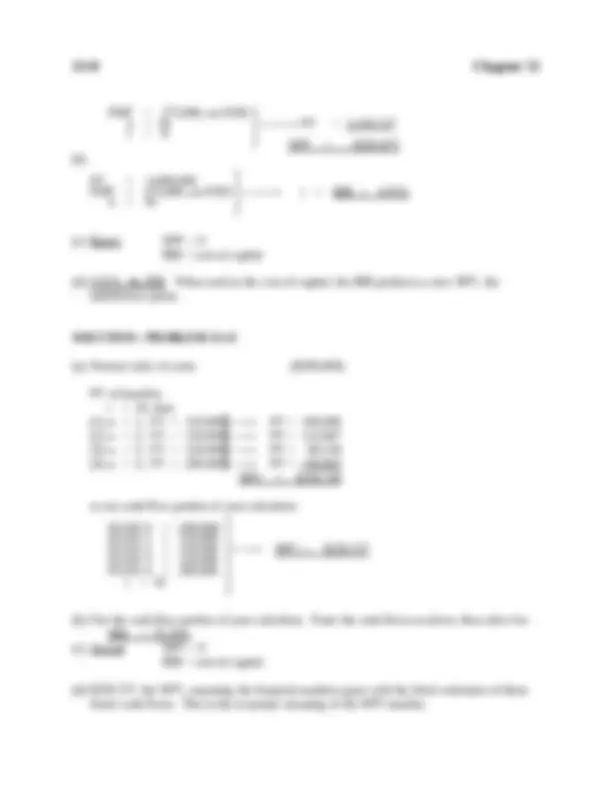
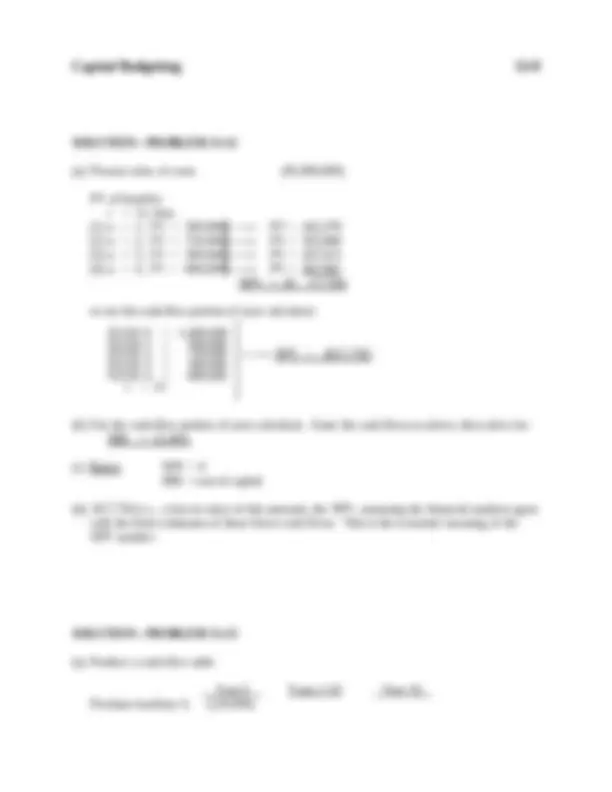
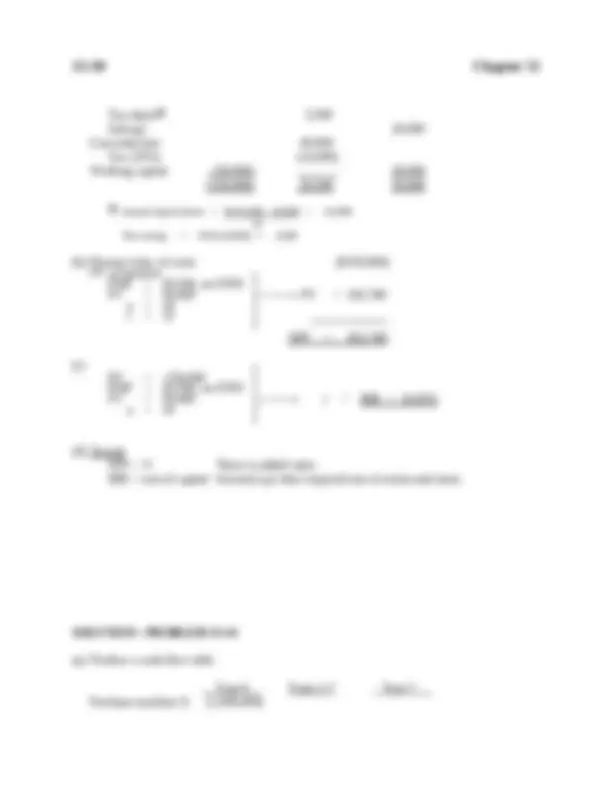
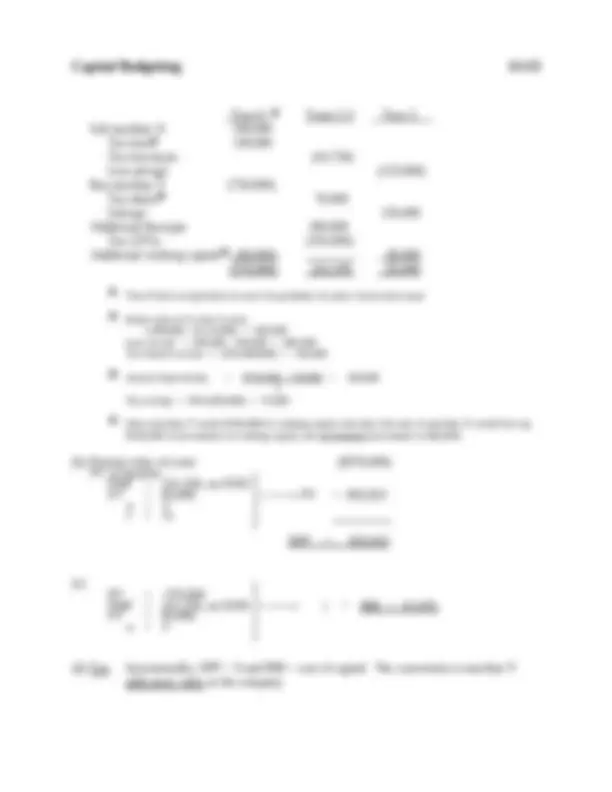
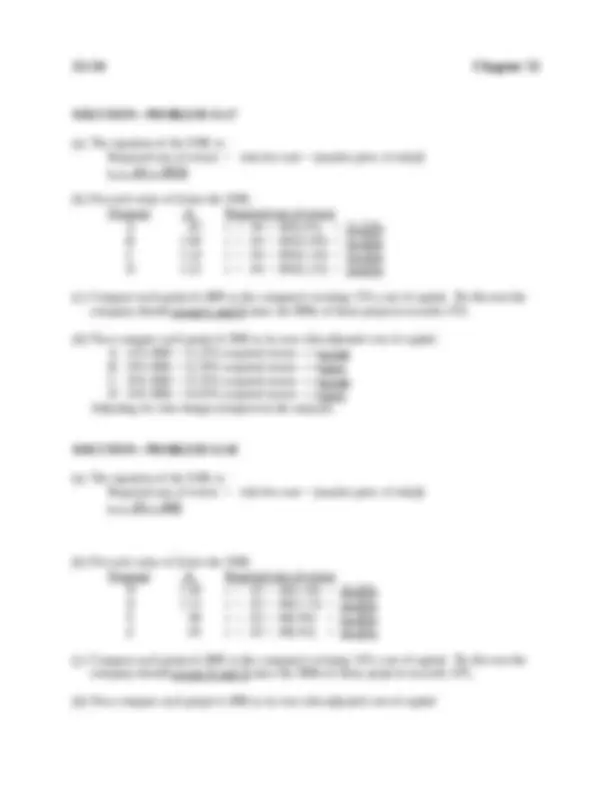

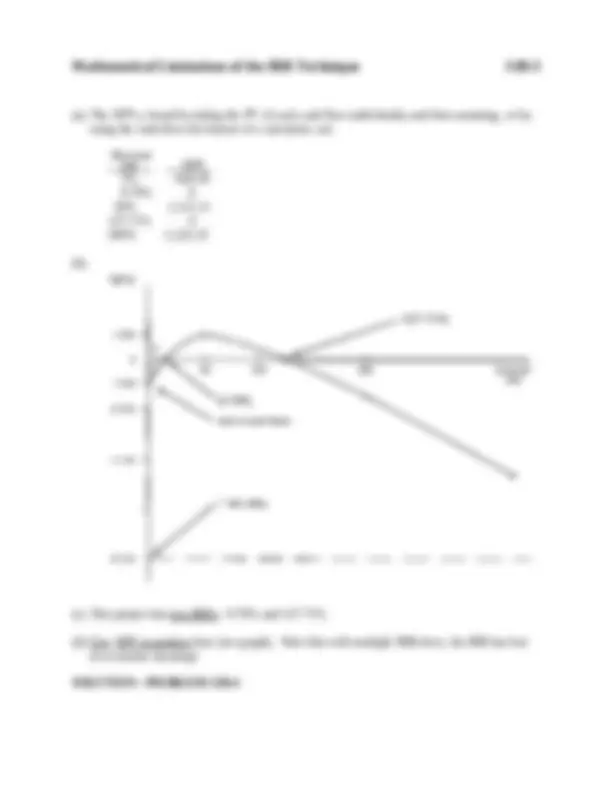
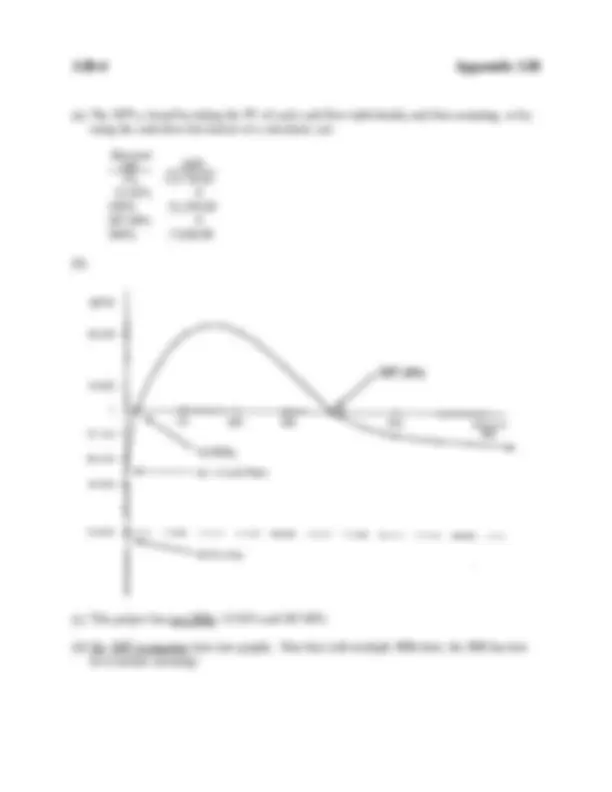


Study with the several resources on Docsity

Earn points by helping other students or get them with a premium plan


Prepare for your exams
Study with the several resources on Docsity

Earn points to download
Earn points by helping other students or get them with a premium plan
Community
Ask the community for help and clear up your study doubts
Discover the best universities in your country according to Docsity users
Free resources
Download our free guides on studying techniques, anxiety management strategies, and thesis advice from Docsity tutors
Solutions to various capital budgeting problems, focusing on the importance of cash flows and the Internal Rate of Return (IRR) in capital budgeting analysis. It explains why cash flows are the underlying determinant of a company's financial value and how IRR is used to test whether the benefits of a project exceed the costs.
Typology: Exercises
1 / 19

This page cannot be seen from the preview
Don't miss anything!












1. Why does capital budgeting analysis pay attention only to cash flows? Capital budgeting looks only at cash flows because finance theory argues that cash flows are the underlying determinant of the financial value of a company. By examining cash flows, capital budgeting analysis measures the exchange of value between a proposed project's projected cash outflows and projected cash inflows to test whether the benefits exceed the costs¾if so, the company's financial value should increase. 2. What is a sunk cost? Why is it ignored in capital budgeting? A sunk cost is a cost that has already taken place. It is ignored in capital budgeting because it cannot be changed by the decision under consideration, hence it is irrelevant to the potential change in the company's financial value that would come from accepting the proposed capital budgeting project. 3. What would happen to a capital budgeting analysis if inflation were omitted from the cash flow estimates? Omitting projected inflation would result in a miscalculation of the cash flows from capital budgeting projects. With incorrect projected cash flows, the subsequent analysis and conclusions could also be incorrect, and the company might invest in a value-decreasing project or miss investing in a value-adding opportunity. 4. What is meant by the “option” inherent in a capital budgeting decision? Every capital budgeting project takes place over a period of time during which a company will face many choices. Examples of these choices are to expand or contract the investment, to replace equipment with newer technology part-way through the project, and to abandon the project altogether. Each of these choices is an option, the opportunity to take whatever course of action is best at that time. By investing in a capital budgeting project, therefore, a company buys not only the immediate project but all subsequent opportunities that derive from it. 5. A financial analyst included the interest cost of the debt used to buy new machinery in the cash flows from a capital budgeting project. Is this correct or incorrect? Why? This is incorrect. The proposed project will be evaluated against a cost of capital after its estimated cash flows are summarized. To include interest in the project's cash flows risks double counting the cost of this capital. In addition, it is not clear which debt will be used to fund the project if it is accepted. Finance theory argues that it is better to wait and incorporate the cost of capital into the analysis after the project's projected nonfinancing cash flows and risks are summarized.
6. What function does a cash flow table play in capital budgeting analysis? A cash flow table is a spreadsheet that organizes cash flows by event and time. It summarizes the flows in a way that makes it easy to apply time value analysis. 7. What is the meaning of: a. Net present value? The net present value of a proposed investment project is the anticipated increase (if positive¾or decrease if negative) in the financial worth of an organization from investing in that project. b. Internal rate of return? The internal rate of return of a proposed investment project is the anticipated interest rate an organization would earn on the money invested in that project. (Analytically, a proposed project's IRR is the discount rate that makes NPV=0.) In what ways are they the same, and how do they differ? They are the same in that they both begin with the projected cash flows from the investment. They differ in the way they match the cash flows against the organization's cost of capital. NPV incorporates the cost of capital directly in the analysis¾as a result, an NPV number is valid only for an organization with that specific cost of capital. IRR first analyzes the investment's projected cash flows without regard to a cost of capital, making the IRR number valid for any organization with the same cash flow estimates. Cost of capital enters in a second step to test whether the IRR is sufficiently high to add financial value. 8. Why is the net present value of a capital budgeting project equal to zero when its internal rate of return is used as the discount rate? Calculating an NPV involves obtaining the present values of future cash flows. These future flows are greater than the project's initial outflow-the IRR describes this difference. If the IRR is used as the discount rate in the NPV analysis, its effect is to exactly remove the greater value in the future cash flows. The present value of these flows becomes equal to the project's initial outlay, and NPV calculates as equal to zero. 9. True or false (and why?): The NPV technique uses the firm's cost of capital in its calculation, but the IRR technique does not. Therefore, the cost of capital is relevant only if capital budgeting projects are evaluated using NPV. False. Although the IRR technique does not use a cost of capital in its first step¾calculating the IRR, a cost of capital is required to proceed with the analysis. It is useless to calculate an IRR unless we can compare it to a cost of capital and see whether the return from the proposed project is sufficiently high to justify investing in it. 10. What is the danger of applying one cost of capital to all proposed capital budgeting projects? Not all capital budgeting projects are of the same risk or time horizon. The Fisher model of interest rates tells us that investor's required rates of return depend on forecasted inflation (a function of time horizon) and risk. As a result, each capital budgeting project has its own hurdle rate, a cost of capital appropriate for its particular combination of time and risk. Applying one cost of capital to all proposed projects runs the risk of making poor
(a) The switch would result in lower depreciation, hence higher income, in the early years of the life of each asset the firm acquires. This pattern will reverse in the later years of ownership since total depreciation must be the same either way. (b) Nothing - GAAP income is not connected to cash flows. (c) Higher taxable income would lead to higher taxes to pay in the early years of asset ownership. This is opposite to the rules of time value of money and would lower the firm's value. (d) Investors and others make judgements about a firm based, in great extent, on its financial statements. Most managers want always to "put their best face forward." SOLUTION - PROBLEM 11 - 3 (a) Should enter the analysis: Cost of addition $500, Cost of new machinery 200, Cost of new wiring 30, Increase to working capital 60, $790, The four items above are all incremental cash flows. (b) Should not enter the analysis Book value of existing plant - neither incremental nor a cash flow. Amount spent on study to date - not incremental, a sunk cost. Interest on loan - a financing flow. (c) This would reduce the need for new working capital and lower the initial investment of part (a) to $790,000 - 15,000 = $775, The answer to part (b) would not change. (d) This would have to be added to the initial outlay since to build the addition is to forego this benefit. $790,000 + $1,500,000 = $2,290, The answer to part (b) would not change here either. SOLUTION - PROBLEM 11 - 4
(a) None - it is a sunk cost! Today's decision cannot change that expenditure. (b) The $75,000 would appear in the ice cream analysis as an incremental cash outflow on the date of the inception of the project ("year 0"). (c) · Alternate uses · What they could be sold for today · How would the ice cream decision change their future pattern of cash flows. (d) · Non-truck related costs (e.g., advertising) · Revenue projections · Quality-related issues · Tax rate. SOLUTION - PROBLEM 11 - 5 (a) The given numbers, since cash-flow numbers must include inflation (b) Year Number 0 - 25, 1 8,000(1.06) = 8, 2 8,480(1.06) = 8, 3 8,989(1.06) = 9, 4 9,528(1.06) = 10, 5 10,100(1.06) = 10, (c) (1) To be accurate forecasts of actual cash flows (2) To be consistent with the cost of capital which does include inflation (d) Without inflation in the cash flows, the forecasted flows would be lower. For a standard project (-, +), this would reduce forecasted inflows and bias the analysis toward a lower NPV and IRR. SOLUTION - PROBLEM 11 - 6 (a) The given numbers, since cash-flow numbers must include inflation (b) Year Number 0 - 70, 1 10,000(1.09) = 10,
(c) Improvement to earnings $80,
PMT = 275,000, set END │ n = 16 │¾¾¾® PV = 2,434, i = 8 │ ┘ NPV = - $565, (b) ┐ PV = - 3,000,000 │ PMT = 275,000, set END │¾¾¾® i = IRR = 4.91% n = 16 │ ┘ (c) Reject NPV < 0 IRR < cost of capital (d) 4.91%, the IRR. When used as the cost of capital, the IRR produces a zero NPV, the indifference point. SOLUTION - PROBLEM 11 - 11 (a) Present value of costs ($200,000) PV of benefits: i = 10, then (1) n = 1, FV = 110,000]¾¾® PV = 100, (2) n = 2, FV = 150,000]¾¾® PV = 123, (3) n = 3, FV = 120,000]¾¾® PV = 90, (4) n = 4, FV = 200,000]¾¾® PV = 136, NPV = $250, or use cash-flow portion of your calculator: ┐ FLOW 0 = - 200,000 │ FLOW 1 = 110,000 │ FLOW 2 = 150,000 │¾¾® NPV = $250, FLOW 3 = 120,000 │ FLOW 4 = 200,000 │ i = 10 │ ┘ (b) Use the cash-flow portion of your calculator. Enter the cash flows as above, then solve for: IRR = 55.10% (c) Accept NPV > 0 IRR > cost of capital (d) $250,727, the NPV, assuming the financial markets agree with the firm's estimates of these future cash flows. This is the economic meaning of the NPV number.
Tax-dep'n^ 3, Salvage 20, Cost reduction 40, Tax (35%) (14,000) Working capital (30,000) 30, (150,000) 29,500 50, (^) Annual depreciation = $120,000 - 20,000 = 10, 10 Tax saving = 35%(10,000) = 3, (b) Present value of costs ($150,000) PV of benefits: ┐ PMT = 29,500, set END │ FV = 50,000 │¾¾¾® PV = 182, n = 10 │ i = 12 │ ┘ NPV = $32, (c) ┐ PV = - 150,000 │ PMT = 29,500, set END │ FV = 50,000 │¾¾¾® i = IRR = 16.64% n = 10 │ ┘ (d) Accept NPV > 0 There is added value. IRR > cost of capital Investors get their required rate of return and more. SOLUTION - PROBLEM 11 - 14 (a) Produce a cash-flow table Year 0 Years 1- 7 Year 7 Purchase machine X (1,000,000)
Tax-dep'n^ 43, Salvage 125, Increased receipts 400, Tax (35%) (140,000) Working capital (100,000) 100, (1,100,000) 303,750 225, (^) Annual depreciation = $1,000,000 - 125,000 = 125, 7 Tax saving = 35%(125,000) = 43, (b) Present value of costs ($1,100,000) PV of benefits: ┐ PMT = 303,750, set END │ FV = 225,000 │¾¾¾® PV = 1,539, n = 7 │ i = 11 │ ┘ NPV = 439, (c) ┐ PV = - 1,100,000 │ PMT = 303,750, set END │ FV = 225,000 │¾¾¾® i = IRR = 21.79% n = 7 │ ┘ (d) Yes NPV > 0 Value is added. IRR > cost of capital Investors get their required rate of return and more. SOLUTION - PROBLEM 11 - 15 (a) Produce a cash-flow table including incremental cash flows: Year 0 ^ Years 1- 5 Year 5 Sell machine A 40, Tax-loss^ 10,
Year 0 ^ Years 1- 3 Year 3 Sell machine X 100, Tax-loss^ 140, Tax-lost dep'n (43,750) Lost salvage (125,000) Buy machine Y (750,000) Tax-dep'n^ 70, Salvage 150, Additional Receipts 300, Tax (35%) (105,000) Additional working capital^ (60,000) 60, (570,000) 221,250 85, (^) Year 0 here is equivalent to year 4 in problem 14, since 4 years have past (^) Book value of X after 4 years: 1,000,000 - 4(125,000) = 500, Loss on sale = 500,000 - 100,000 = 400, Tax benefit on loss = 35%(400,000) = 140, (^) Annual depreciation = $750,000 - 150,000 = 200, 3 Tax saving = 35%(200,000) = 70, (^) Since machine Y needs $160,000 of working capital and since the sale of machine X would free up $100,000 of investment in working capital, the incremental investment is $60,000. (b) Present value of costs ($570,000) PV of benefits: ┐ PMT = 221,250, set END │ FV = 85,000 │¾¾¾® PV = 602, n = 3 │ i = 11 │ ┘ NPV = $32, (c) ┐ PV = - 570,000 │ PMT = 221,250, set END │¾¾¾® i = IRR = 14.10% FV = 85,000 │ n = 3 │ ┘ (d) Yes Incrementally, NPV > 0 and IRR > cost of capital. The conversion to machine Y adds more value to the company.
(a) The equation of the SML is: Required rate of return = risk free rate + (market price of risk)b r = .04 + .085b (b) Put each value of b into the SML: Proposal b Required rate of return A .85 r = .04 + .085(.85) = 11.23% B 1.00 r = .04 + .085(1.00) = 12.50% C 1.10 r = .04 + .085(1.10) = 13.35% D 1.25 r = .04 + .085(1.25) = 14.63% (c) Compare each project's IRR to the company's existing 13% cost of capital. By this test the company should accept C and D since the IRRs of those projects exceeds 13%. (d) Now compare each project's IRR to its own risk-adjusted cost of capital: A: 12% IRR > 11.23% required return ¾®accept B: 10% IRR < 12.50% required return ¾®reject C: 16% IRR > 13.35% required return ¾®accept D: 14% IRR < 14.63% required return ¾®reject Adjusting for risk changes (improves) the analysis. SOLUTION - PROBLEM 11 - 18 (a) The equation of the SML is: Required rate of return = risk free rate + (market price of risk)b r = .05 + .08b (b) Put each value of b into the SML: Proposal b Required rate of return W 1.40 r = .05 + .08(1.40) = 16.20% X 1.15 r = .05 + .08(1.15) = 14.20% Y .90 r = .05 + .08(.90) = 12.20% Z .65 r = .05 + .08(.65) = 10.20% (c) Compare each project's IRR to the company's existing 14% cost of capital. By this test the company should accept W and X since the IRRs of those projects exceeds 14%. (d) Now compare each project's IRR to its own risk-adjusted cost of capital:
(a) Produce a cash-flow table: Year 0 Years 1- 4 Sell machine 5, Tax-gain^ (1,750) Lost savings (3,000) Tax (35%) 1, 3,250 (1,950) (^) Gain on sale = sale price - book value = 5,000 - 0 = 5, Tax on gain = 35% × 5,000 = 1, PV of year 0 benefit $3,250. PV of year 1-4 costs: ┐ PMT = - 1,950, set END │ n = 4 │¾¾¾® PV = (6,181.24) i = 10 │ ┘ NPV = ($2,931.24) (b) ┐ PV = 3,250 │ PMT = - 1,950, set END │¾¾¾® i = IRR = 47.23% n = 4 │ ┘ (c) No, the company should not sell the machine. To do so would be to lose value of $2,931.24. (d) Since this is an opposite project (+, - ), an IRR greater than the cost of capital is the reject signal, agreeing with the negative NPV. The $3,250 opportunity of selling the machine can earn at a 47.23% rate if we leave the investment untouched. Also, to go ahead and sell the machine would be the equivalent of raising $3,250 of funds at a 47.23% rate of interest. Do not pay this rate, hence do not sell the machine. SOLUTION - PROBLEM 11B - 2
(a) Produce a cash-flow table: Year 0 Years 1- 2 Sell machine 20, Tax-gain^ (7,000) Lost savings (11,000) Tax (35%) 3, 13,000 ( 7,150) (^) Gain on sale = sale price - book value = 20,000 - 0 = 20, Tax on gain = 35% × 20,000 = 7, PV of year 0 benefit $13,000. PV of year 1-2 costs: ┐ PMT = - 7,150, set END │ n = 2 │¾¾¾® PV = (11,926.93) i = 13 │ ┘ NPV = $1,073. (b) ┐ PV = 13,000 │ PMT = - 7,150, set END │¾¾¾® i = IRR = 6.60% n = 2 │ ┘ (c) Yes, the company should sell the machine. This would add $1,073.07 of value to the firm. (d) Since this is an opposite project (+, - ), an IRR less than the cost of capital is the accept signal, agreeing with the positive NPV. The $13,000 from selling the machine can be better used elsewhere; it is currently earning only 6.60%, far less than the 13.00% WACOC. Also, to sell the machine would be the equivalent of raising $13,000 of funds at a rate of 6.60%, very attractive when capital is averaging a 13% cost. SOLUTION - PROBLEM 11B - 3
(a) The NPVs, found by taking the PV of each cash flow individually and then summing, or by using the cash-flow-list feature of a calculator, are: discount rate NPV 5% - 13,718. 12.92% 0 100% 31,250. 387.08% 0 500% - 7,638. (b) (c) This project has two IRRs: 12.92% and 387.08%. (d) No, NPV is negative here (see graph). Note that with multiple IRRs here, the IRR has lost its economic meaning!